Above image: War correspondent Ernie Pyle reported on World War II from England, North Africa, Italy, France, Saipan, and Okinawa. Courtesy of the Library of Congress.
When the United States entered World War II, Americans everywhere mobilized to support the war effort. Journalists, novelists, and academics were no exception. Prominent authors such as John Steinbeck, John Hersey, Pearl Buck, and Martha Gellhorn all lent their considerable talents to the war effort, but the most famous American writer during World War II was a soft-spoken journalist from Dana, Indiana, named Ernie Pyle.
Ernest Taylor Pyle was born on August 3, 1900. Ernie was an only child who grew up working on the 80-acre grain farm his parents rented. Childhood acquaintances remembered him as a shy and intelligent boy who yearned for adventure and to travel the world. After graduating high school, Ernie enlisted in the United States Naval Reserve in October 1918, but did not get a chance to see service overseas before World War I ended. His hopes of military glory dashed, Ernie instead started college at Indiana University in the fall of 1919. Though Ernie majored in economics, he took a number of journalism classes and was an editor of the school newspaper.
While still in college, Ernie took every opportunity to travel. He labored in a Kentucky oil field during the summer of 1920, and in the spring of 1922 he accompanied Indiana University’s baseball team to Japan by working as a cabin boy. He was delighted that his paperwork prevented him from staying in Japan so that he had to remain with the ship as it continued on to China and the Philippines. Upon Ernie’s return, and just one semester before he was to graduate, he left school to become a reporter for LaPorte (Indiana) Herald-Argus. Ernie’s self-deprecating and earnest manner enabled him to make friends easily, and his work ethic quickly won him the respect of his superiors. But the ever-restless reporter worked for the paper barely four months before moving to Washington, DC to take another job as a reporter for The Washington Daily News, a newly created tabloid in the Scripps-Howard newspaper chain. Ernie’s boss praised the young reporter’s direct and engaging writing style, and promoted him to copy editor. In October 1923, Ernie met a rebellious young woman named Geraldine “Jerry” Siebolds, and the pair began dating a few months later. Less than a year into Ernie’s stint in Washington, he again succumbed to restlessness and took a job working on a Caribbean freighter. When he finally returned to Washington two years later, he married Jerry in a civil ceremony in Virginia. The couple promptly bought a Model T and proceeded to travel the country for three months.
After ending up in New York City, where the pair sold the car to pay for food, Ernie found work with the The Evening World and later at the The Evening Post. His meager paycheck enabled the couple to survive, but not to enjoy the Jazz Age metropolis. In December 1927, the Washington Daily News came knocking again, and by the end of the month Ernie was back at the same desk in Washington, DC that he had left a few years earlier. Ernie was initially put in charge of all the wire copy for the paper, but he soon approached the managing editor with the idea of writing an aviation column. The editor consented, and Ernie began a daily column covering all aspects of aviation. After Ernie finished his eight hour shift each day, he rode the streetcar out to airfields around Washington to chat with pilots and trade stories. His column, “D.C. Airports Day by Day,” captured the excitement and romanticism of an era that is primarily remembered today for Charles Lindbergh’s solo transatlantic flight.
Ernie befriended dozens of pilots by hanging around the hangars and chatting over late night cigarettes. His quiet manner often gave him inside tips before other reporters who aggressively interrogated pilots. Ernie had a special fondness for the anonymous working men of the burgeoning field of aviation. His favorite subjects to write about were the mail pilots who braved harrowing conditions and intense fatigue to deliver the mail on schedule. His column about mail pilot Bill McConnell was typical of his writing at the time. Ernie explained that Bill “has never been to the North Pole, or the South Pole, or flown across the ocean at midnight with a pig in his lap, or stayed in the air a week without changing his socks…. No, all he ever did was fly the night air mail between Cleveland and Cincinnati every night for 34 consecutive nights last winter. Two hundred and thirty-eight hours in the air in a month.”
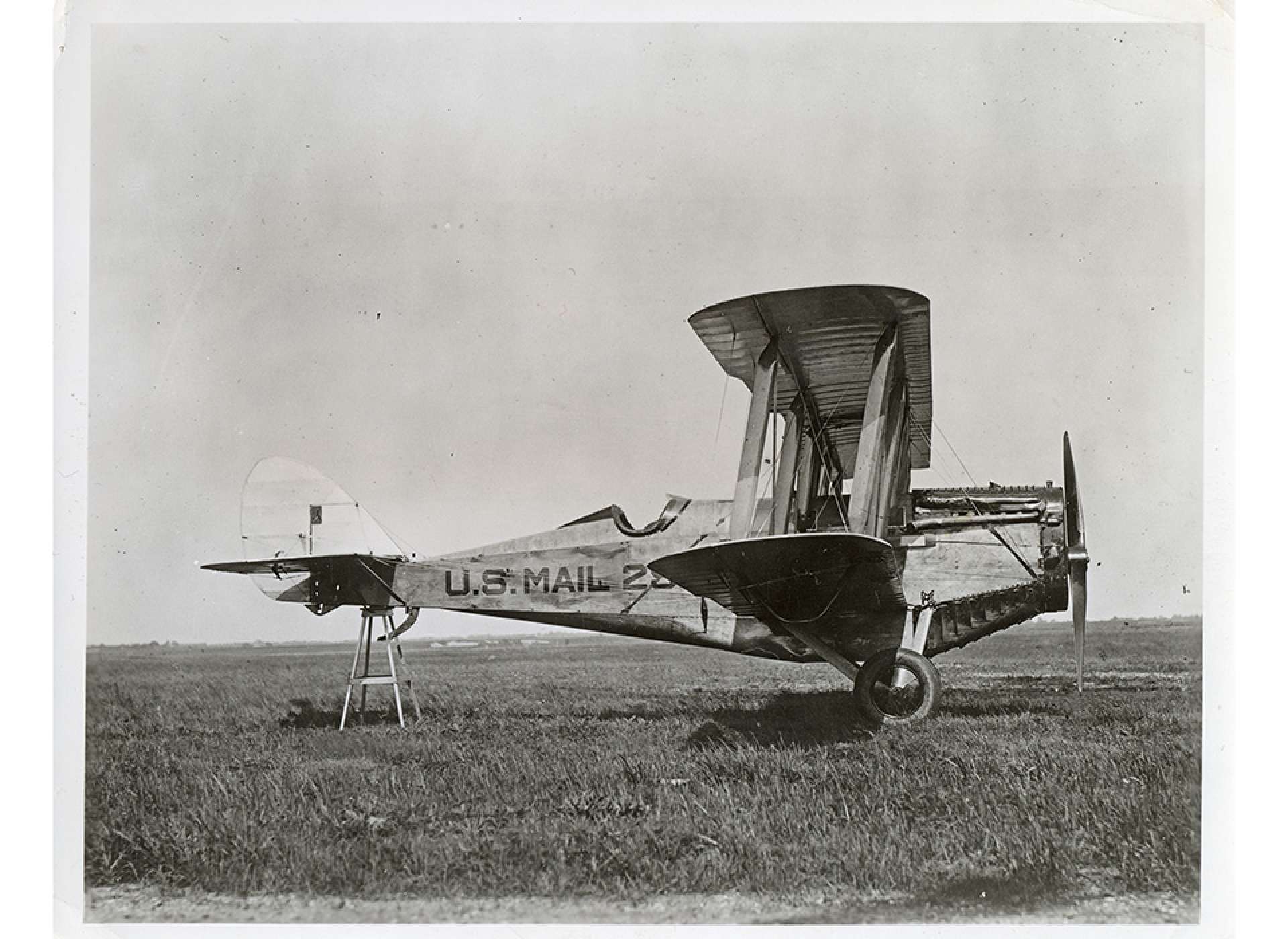
A De Havilland biplane used to deliver mail in the 1920s courtesy of the National Postal Museum.
Ernie profiled men like Bill McConnell to demonstrate that the men who grabbed headlines with daredevil stunts were not the only heroes in the air. Ernie had a gift for telling brief but compelling stories about minor incidents in which pilots struggled through a sudden storm or grappled with mechanical difficulties. He quickly found his niche by writing human interest pieces instead of hard-hitting news. Soon the publisher relieved Ernie of his copyediting duties entirely, and made Ernie the aviation editor for all Scripps-Howard outlets. He became one of the most prominent aviation writers of the time, and frequently met with congressmen, army officers, and famed aviators like Amelia Earhart.
After four years of writing about aviation, Ernie was asked to become the managing editor of the Washington Daily News in 1932. Ernie accepted the post because he did not want to let his employer down, though he knew it meant a return to the humdrum daily routine he despised, and an end to the travel and writing he loved. For the next three years, Ernie threw himself into the work, but he did not enjoy managing the paper’s daily operations.
Ernie desperately needed to escape, so he conceived the idea for a roving reporter who would travel the world writing stories about the people he met. Ernie pestered the chief editor about the idea until the latter finally relented in 1935. For the next six years, Ernie and Jerry traveled the world with only short intermissions. By 1940, Ernie figured he had “covered 200,000 miles and been on five of the six continents and crossed both oceans and delved into every country in the Western Hemisphere and written upward of 1,500,000 words.” He talked to rich and poor people alike. Everyone from movie producers and millionaires to steelworkers and sheepherders made their way into his column. His pieces captured snapshots of the nation he was in, both its people and landscape. Ernie especially sought out individuals with unusual stories. Moreover, his pieces enjoyed a wide readership at a time when money was scarce and working class families often could not travel. In addition to his interesting subjects, Ernie conveyed the “aw shucks” personality of a simple man writing for other average folks.
As Ernie journeyed through the American West, he captured the despair of the Dust Bowl. He witnessed the devastation that years of drought and plagues of locusts had wrought on the landscape. After driving through a dust storm, he described how “the sand-laden wind cut across the highway like a horizontal waterfall. Sand was not drifting, or floating, or hanging in the air—it was shooting south, in thick veins, like air full of thrown baseballs.” In the old South, Ernie explored the intense poverty of sharecroppers and the struggles of polio victims at Warm Springs, Georgia. It was common knowledge President Franklin Roosevelt occasionally visited Warm Springs, but his struggle with polio was largely hidden from public view. Ernie’s piece was titled “Celebrating Hope” and conveyed the dignity and cheerfulness of life at the the beautiful sanitarium.
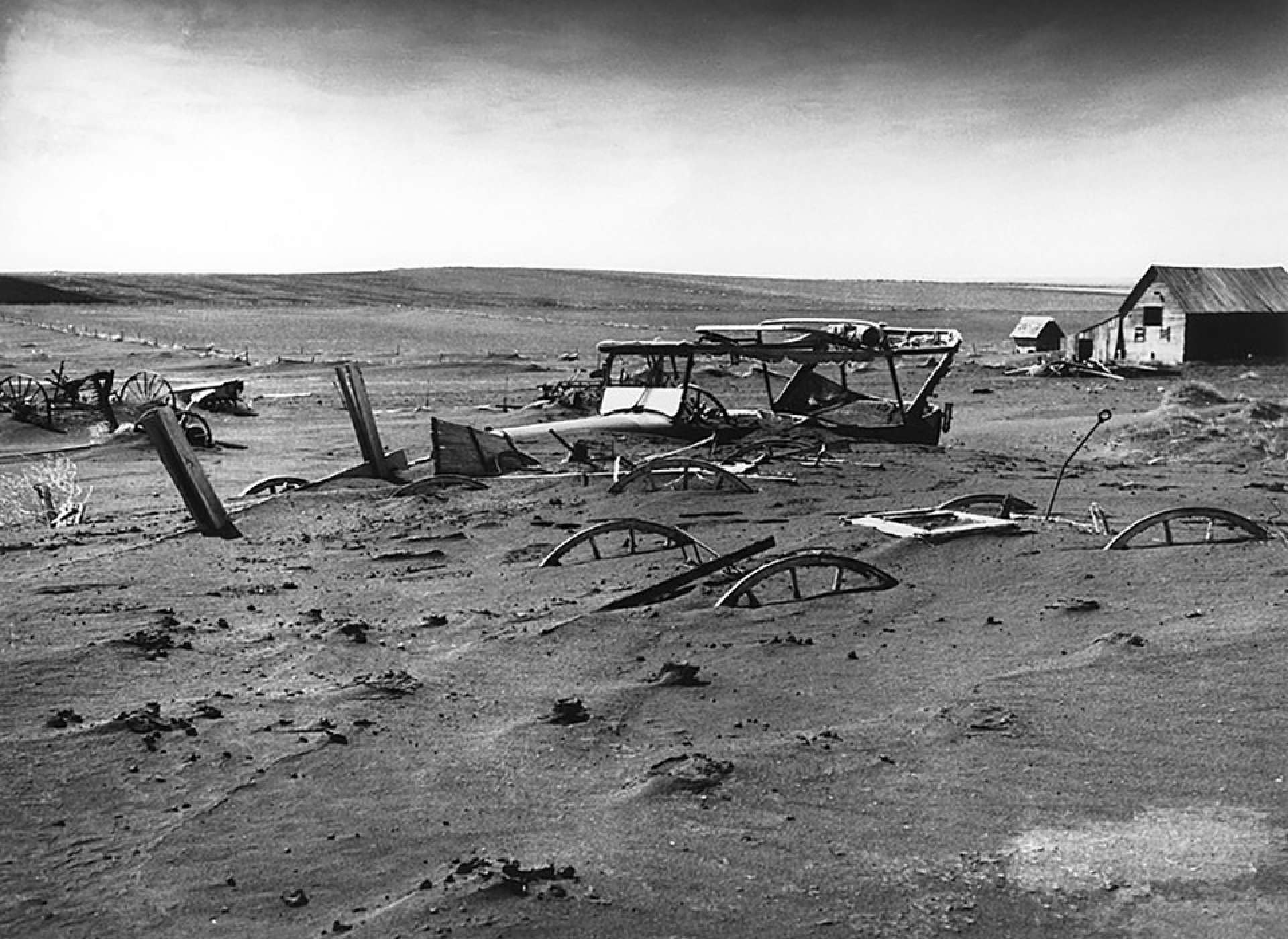
An automobile and farm machinery buried by dust in South Dakota in 1936 courtesy of the US Department of Agriculture.
Ernie wrote many humorous and uplifting pieces about people and places too. When Ernie visited Pittsburgh he declared it to be “undoubtedly the cockeyedest city in the United States” because even the “people who live there can’t find their way around” its confusing streets and complex topography. Ernie made no pretense at objectivity in his pieces, and when the humble journalist met the ailing Dr. George Washington Carver, Ernie stated unequivocally that the famed African American scientist surpassed every other man in nobility and intelligence. Ernie’s pieces were so compelling that they frequently stirred readers to action with their honest forthright language. When Ernie told the story of a bellhop in Miami, for example, letters poured into the Scripps-Howard offices from across the country offering the man help to better his station.
Ernie loved traveling, talking to people, and writing, even though he strained under the pressure of writing six columns a week. After a tour of Central America, his editor ordered him to rest for several weeks. Ernie took the opportunity to visit old friends in Florida. He was still on sabbatical there when Nazi Germany invaded France in May of 1940. The American people’s apparent lack of reaction to the war shocked Ernie. In contrast, the conflict fascinated him, and he wanted to see the front lines for himself.
Despite the initial objections of his editor, Ernie finally wrangled permission to sail for England. He expected a spirit-cleansing experience in beleaguered London, and although the trip did not change his soul in the way he hoped, it did transform him into the most prominent newspaper correspondent in America. Ernie landed in England in December 1940 and immediately fell in love with the country. He thought the people and sights were straight “from a Dickens novel.”
Ernie had expected a bomb-battered London, but instead he found a bustling city. All the Thames bridges still stood, as did Big Ben, although Ernie noted the old clock was not keeping time. He confidently asserted “London is no more knocked out than the man who smashes a finger is dead.” Several days after Ernie’s arrival, he experienced his first big air raid. From a darkened balcony he watched as incendiary bombs rained down on the great city. He described the feeling of awe he felt at seeing “the whole horizon of a city lined with great fires—scores of them, perhaps hundreds.” Ernie called the bombings savage, and praised the anonymous heroes who raced across rooftops to douse the incendiaries with sand before they could set buildings alight. He felt the shudder of the bombs and the thump of anti-aircraft guns. In writing about the experience, Ernie did in print what Edward Murrow did on the radio. Ernie made Americans feel the Britons’ determination and the horrors that the Germans were inflicting on unarmed citizens. Ernie left his readers with the image of “London stabbed with great fires, shaken by explosions, its dark regions along the Thames sparkling with the pin points of white-hot bombs, all of it roofed over with a ceiling of pink that held bursting shells, balloons, flares and the grind of vicious engines.” Ernie did not pretend to give his readers a definitive account of the battle. Rather he gave his own impressions and feelings that London was resilient, and would survive at a time when many Americans had doubts.
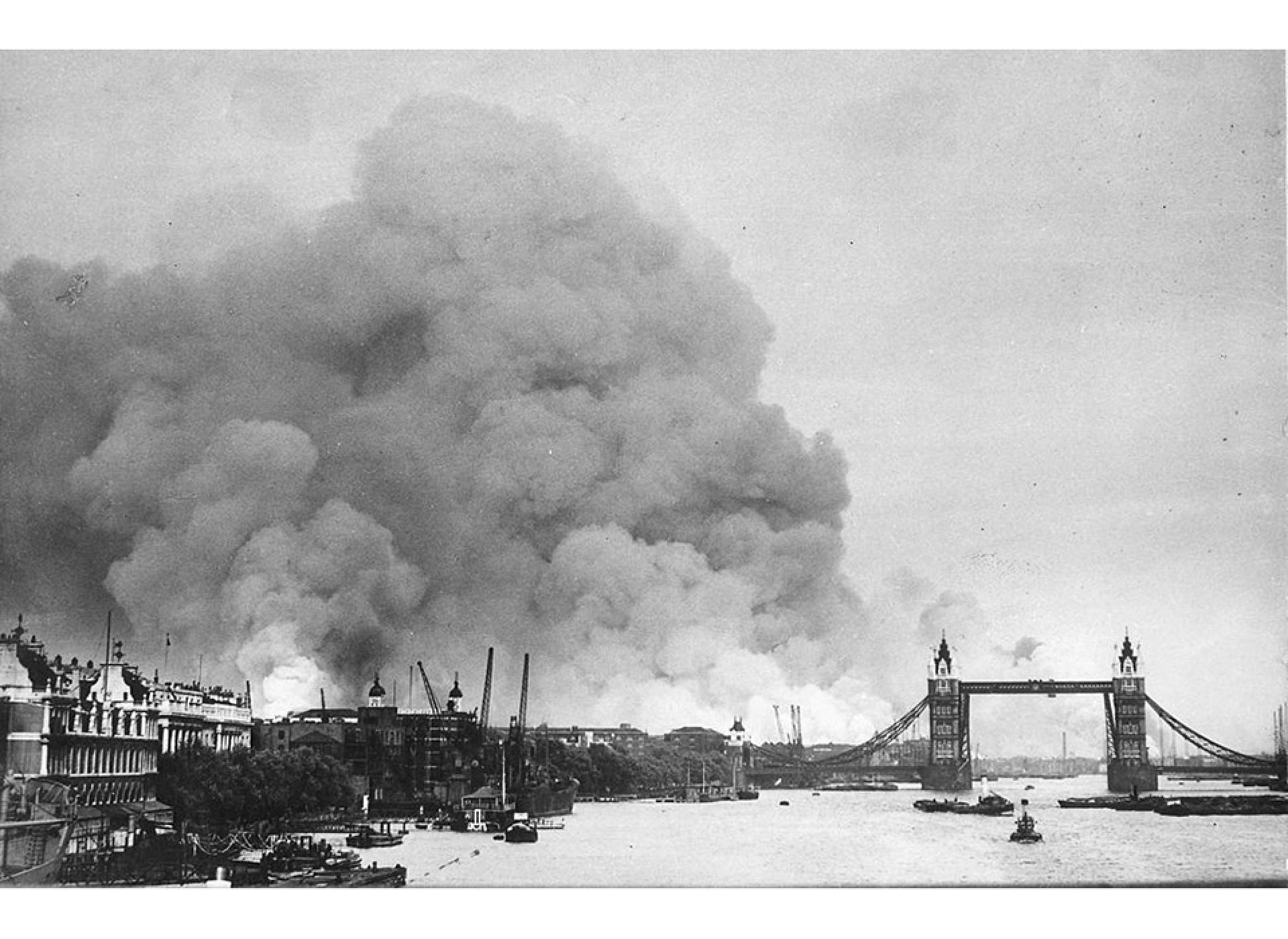
Docks burn in London after a German bombing raid in September 1940 courtesy of the National Archives and Records Administration.
Ernie’s columns from London were received with universal acclaim. When he returned home, he was a household name. A publisher approached him about printing his columns from Great Britain into a book, Ernie Pyle in England, which was released in late 1941. He dedicated it to “That Girl Who Waited.” Following Ernie’s trip, he retired to his home in Albuquerque for a three month leave of absence to care for Jerry, who was increasingly suffering from depression and suicidal thoughts. After his writing hiatus came to an end, Ernie began to plan another trip, this time to Asia where he would visit China, the Philippines, and the Dutch East Indies. He was slated to leave in November 1941, but the State Department delayed the trip at the last minute. A few weeks later Japanese forces bombed Pearl Harbor, and the United States entered World War II.
Ernie drove at once to California where the war anxiety was at a fever pitch. Rumors of a Japanese invasion fleet off the Pacific coast ran rampant. After a month of waiting in California, however, Ernie grew bored. To make matters worse, his marriage was suffering from the stress of long separations. He and Jerry divorced in April. Unsure what to do next, Ernie tried to join the Navy but was rejected for being too small.
One friend suggested Ernie resume his roving column as a distraction from the discouraging war news blanketing newspapers. Instead, Ernie decided to embark on a tour of the war zone in England, where Allied forces were staging for a strike against the Axis.
By August 1942, Ernie was back in England, this time writing pieces about American soldiers’ lives and their relations with the British. He petitioned for a draft deferment to remain a war correspondent, and subsequently followed American and British soldiers in the invasion of North Africa in November 1942.
At 42-years-old with graying hair and a thin build, Ernie stood out from the average GI, but his penchant for making friends made him welcome wherever he went. Officers appreciated his presence as a way to drum up support for their campaigns, and soldiers wanted to get their names in the papers to let friends back home know they were alright. Ernie happily obliged them. He turned out pieces about military policemen, quartermasters, and airmen, but he had the most sympathy for the plight of the infantryman. Ernie’s column was a resounding success. People eagerly read his descriptions of North Africa, the battlefields, and US soldiers to see what their boys experienced. Soldiers liked the column too. Lieutenant Charles F. Marshall of the US Sixth Corps recorded in his diary that Ernie’s writing was “Quite good. He catches the spirit. Nothing phony in it anywhere.”
Ernie’s column maintained a delicate balance. He did not succumb to despair, but he also did not gloss over the reality of the war. For example, Ernie mentioned in one article that despite the battlefield heroics of medics, the shortage of stretcher bearers in the medical service meant that some wounded men went untreated for 24 hours. Ernie did, of course, exclude some of the most unpleasant aspects of the conflict, including the horrible damage it wrought on men’s bodies and minds. Overall, Ernie’s pieces did not hide the fact that the war meant suffering for soldiers. Still, he paired this sentiment with the resolve he saw among the Americans and British troops, who regularly bested the Germans, albeit at a heavy cost.
Ernie was usually just a few miles from the front lines, but he survived a number German artillery barrages and bombing raids. He also witnessed several distant engagements. In one column he mentioned a conversation with a tank crewman just before the latter took part in an advance. Less than two hours later, Ernie watched from a hilltop as the man’s tank was hit and he was killed.
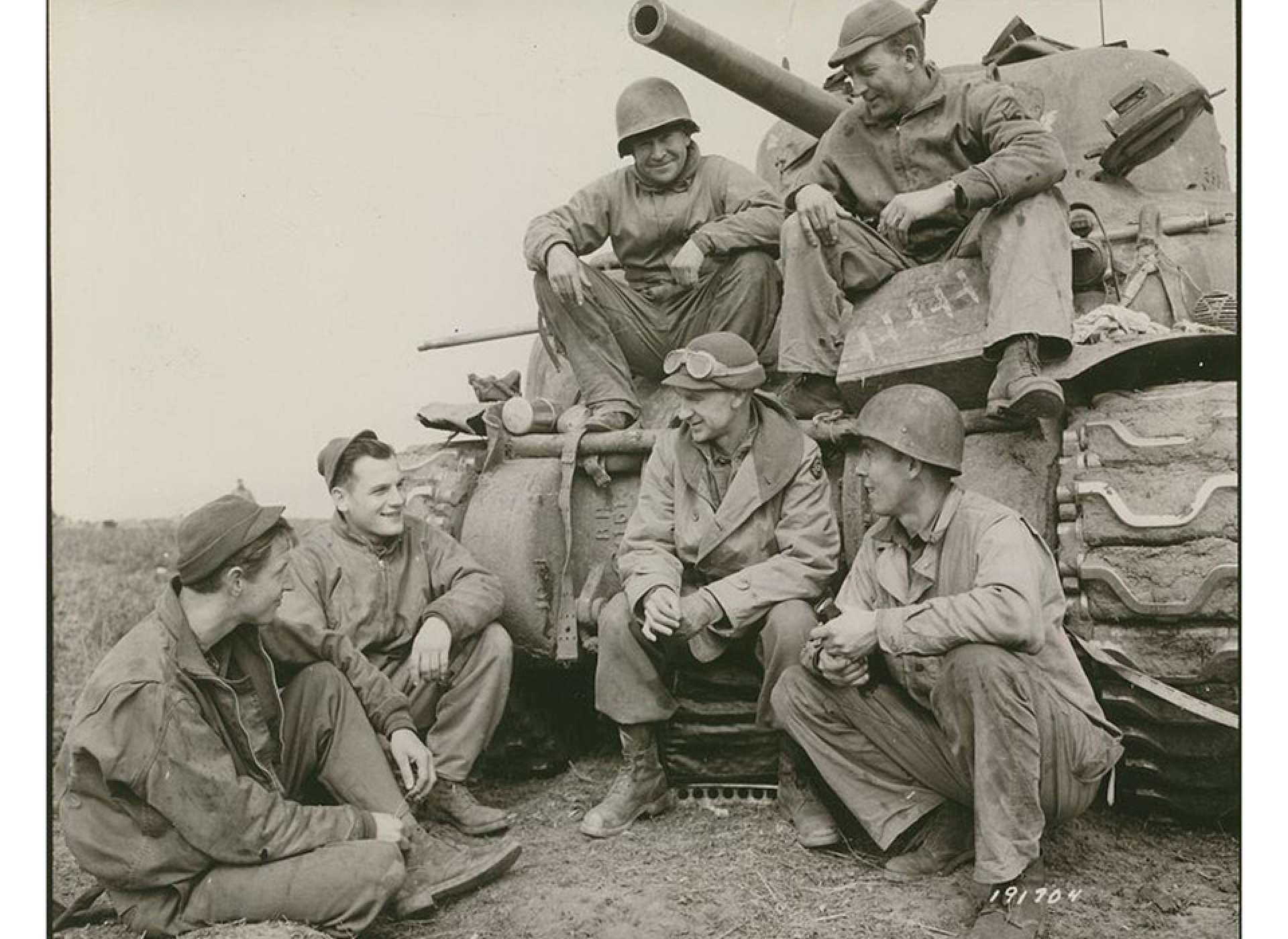
Ernie Pyle talks to tankers from the US Army's 191st Tank Battalion courtesy of the US Army Center for Military History.
Ernie liked to mention specific units, which gave their soldiers an immense source of pride. Ernie explained how he felt “a loyalty to the First Division” which he accompanied “off and on for six months.” But he found it “sad because the men go, and new ones come and they go, and other ones come until at last only the number of the division is left.” Resigned to this eventuality, Ernie noted that “As long as we have an army, the First Division will exist, but my friends in it may not.”
Far from depressing readers in the United States, Ernie’s honest depictions of soldiers were exactly what the public wanted. At the conclusion of the campaign in North Africa, Ernie followed American forces in the invasion of Sicily in July 1943. By the time the campaign for Sicily ended a month later, Ernie was suffering from exhaustion and what he called “a state of mental dullness.” In mid-August, 1943, Ernie returned home to rest. Unexpectedly, he found himself a national celebrity upon his return. His North Africa dispatches were compiled and published under the title, Here Is Your War, and autograph seekers mobbed Ernie wherever he went. Scripps-Howard was besieged with requests for Ernie to give lectures and interviews. Government officials wanted Ernie’s help selling war bonds, and his book sold so well that the publisher had to petition the government for more rationed paper to print six editions by May of 1945. Ernie put into words what many soldiers wanted to say, but could not. Yet the sudden fame and success made Ernie uncomfortable. He felt he had done his best writing years ago, and that now public attention was focused on him exclusively because of the war. Consequently, Ernie only consented to be portrayed in a film based on Here Is Your War on the condition that it focused on the soldiers and depicted other war correspondents as well.
Ernie returned to Europe in December of 1943, no longer out of any longing for the front, but out of a sense of guilt. He felt a responsibility to do his part when millions of other men had no option to stay home. During the next three months, he wrote some of his most poignant pieces of the war. His most famous column recounted the reactions of soldiers to the death of their beloved company commander, Captain Henry T. Waskow. In another, Ernie described platoon leader Buck Eversole, a former ranch hand. “The years rolled over him and the war became his only world, and battle his only profession. He armored himself with a philosophy of accepting whatever might happen.” So, too, did Ernie assume the life of the soldier. He narrowly escaped a bombing raid at Anzio, and followed the slow advance up the Italian peninsula until February 1944, when he travelled back to England to await the invasion of France.
In May, Ernie was stunned to learn that he had been awarded the Pulitzer Prize “for distinguished war correspondence during the year 1943.” The prize committee specifically requested that Ernie’s editor submit his pieces for consideration. Ernie’s editor was delighted, even more so because he had never heard of the committee soliciting a submission.
The following month, Allied forces landed in Normandy. Ernie had intended to go ashore several weeks after the landings, but felt he could not refuse an invitation to watch the landings from the bridge of General Omar Bradley’s flagship, the cruiser Augusta. The next day, he observed the wreckage as he walked on Omaha Beach. “Submerged tanks and overturned boats and burned trucks and shell-shattered jeeps and sad little personal belongings were strewn all over those bitter sands,” Ernie told his readers. “After it was over it seemed to me a pure miracle that we ever took the beach at all.” Ernie stayed in France for two more months until he again reached his breaking point. The 43-year-old suffered from the stress of living near the front lines, but also from seeing so many young men killed and maimed.
In the fall of 1944, Ernie returned home to a hero’s welcome. Yet, after just a few short months, Ernie again felt compelled to go back to the fighting front. He stated publicly that he needed to rectify his one-sided focus on the forces in Europe and cover the Pacific theater. Ernie departed from California in January 1945. His voyage took him to Hawaii, Guam, and Saipan, where he wrote about B-29 crews who bombed Japan. A close friend marveled at Ernie’s methods. He seemed to loaf around just chatting with the men for days before secluding himself and producing large stacks of copy. Ernie did not take notes, yet could recall conversations virtually verbatim.
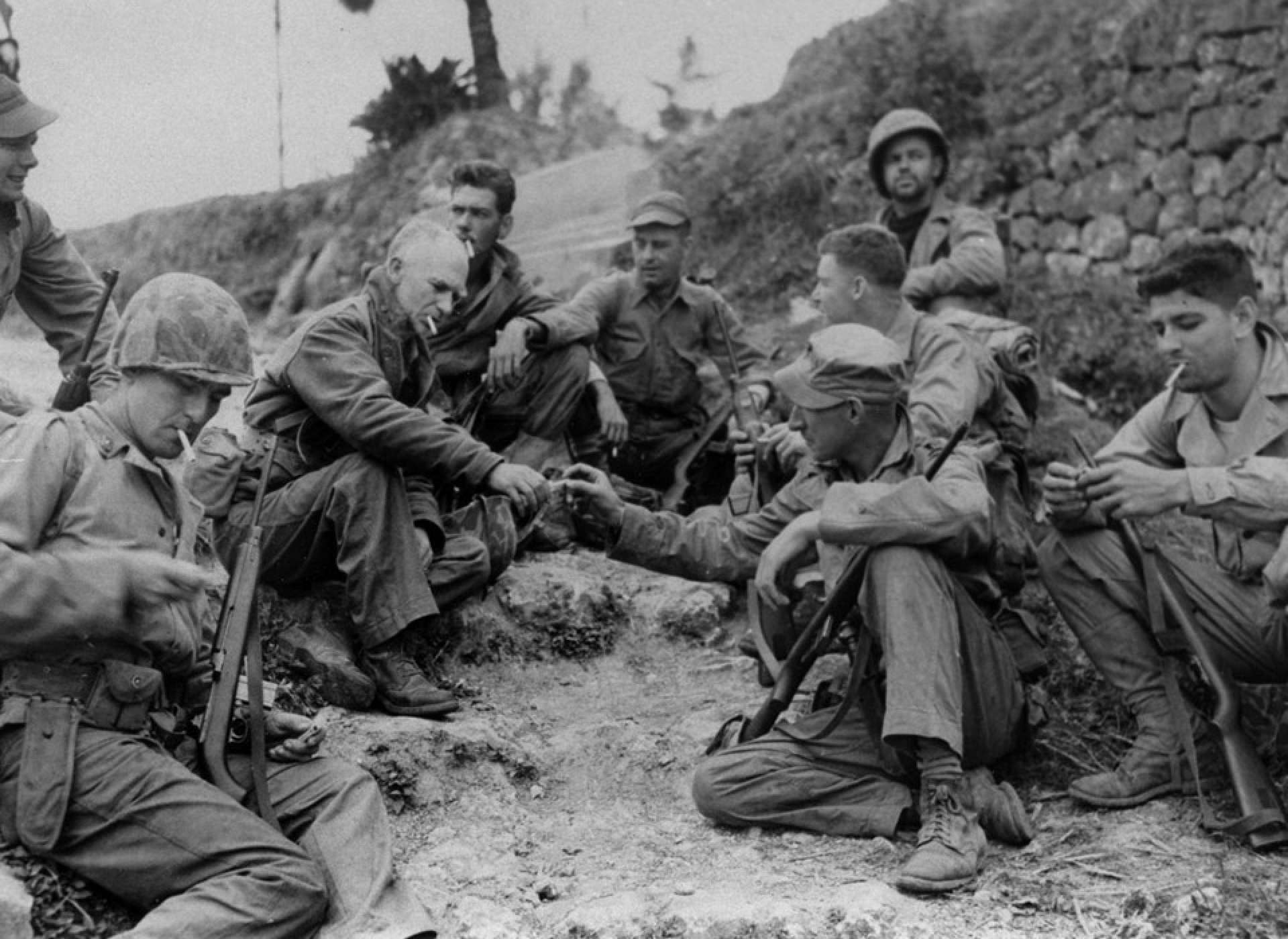
Ernie Pyle with Marines from the First Marine Division on Okinawa on April 8, 1945 courtesy of the US Marine Corps.
In March, Ernie sailed with the Allied invasion fleet bound for Okinawa. A few weeks later, he reported that “We are firmly on Okinawa, which is like having your foot in the kitchen door.” On April 17, 1945 Ernie went ashore on the little island of Ie Shima off the coast of Okinawa. The US Army’s 77th Infantry Division was in the final stages of securing the small airfield on the ten-square-mile island. The following morning, Ernie was riding in a jeep with an army officer when a hidden Japanese machine gunner opened fire. Ernie and his companion dove into a nearby ditch, but when Ernie raised his head a short time later, a bullet struck him just below the rim of his helmet. He was 44 years old.
Ernie Pyle’s death dealt a blow to Americans still reeling from the loss of President Franklin D. Roosevelt on April 12. President Harry S. Truman paid tribute to the fallen correspondent, as did former First Lady Eleanor Roosevelt, who fondly remembered meeting him. In 1946, a selection of Ernie’s Pacific theater pieces were published posthumously under the title Last Chapter. Today his work is still the yardstick by which all other war reporting is judged. Although Ernie constantly worried that he was unable to give Americans the full picture of how horrible the war truly was, soldiers themselves thought he came closer than anyone else. Their affection for Ernie was evident on the monument erected on the site of his death:
AT THIS SPOT
THE 77th INFANTRY DIVISION
LOST A BUDDY
ERNIE PYLE
18 April 1945
Suggested Further Reading:
Ernie Pyle, Home Country (New York: William Sloane Associates, 1947).
Ernie Pyle, Ernie Pyle in London (New York: Robert M. McBride & Company, 1941).
Ernie Pyle, Here is Your War (New York: World Publishing Company, 1943).
Ernie Pyle, Brave Men (New York: Henry Holt and Company, 1944).
Ernie Pyle, Last Chapter (New York: Henry Holt and Company, 1946).
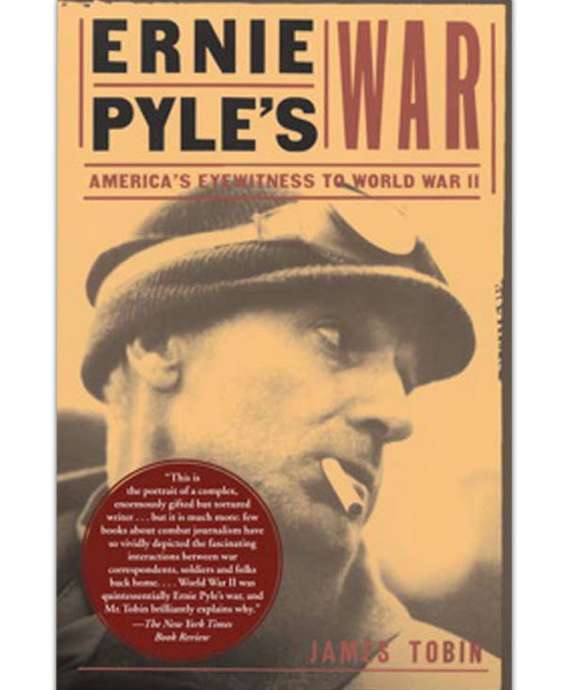
Ernie Pyle's War: America's Eyewitness to World War II
Learn more about Ernie Pyle in this "superbly documented and compassionate account" (Publishers Weekly) by James Tobin. Every Museum Store purchase helps further our education mission.
This article is part of an ongoing series commemorating the 75th anniversary of the end of World War II made possible by Bank of America.
Tyler Bamford
Tyler Bamford was the Sherry and Alan Leventhal Research Fellow at the Institute for the Study of War and Democracy at The National WWII Museum from 2019-2021. He obtained his PhD in history from Temple University and his BA in history from Lafayette College.
Cite this article:
MLA Citation:
APA Citation:
Chicago Style Citation:
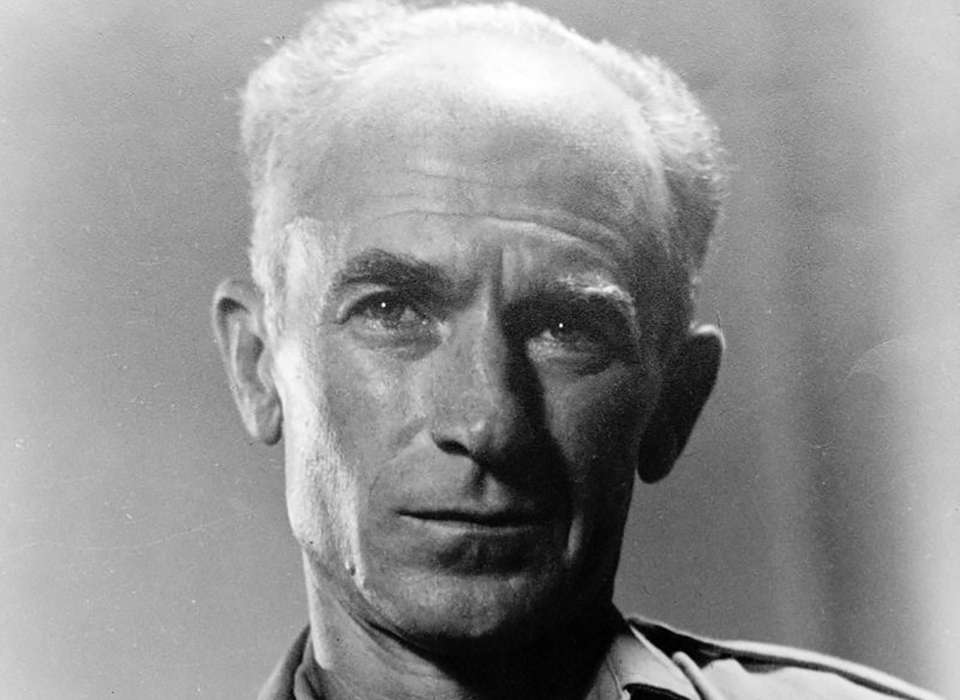







![Max Fuchs, New York City cantor, sings as Rabbi Sydney [sic] Lefkowitz, Richmond, VA, conducts the first Jewish services from Germany.](/sites/default/files/styles/max_650x650/public/2025-10/image1.jpg)

